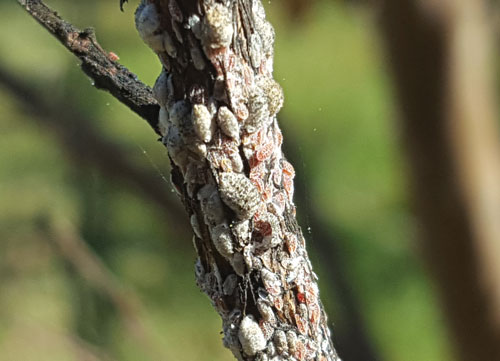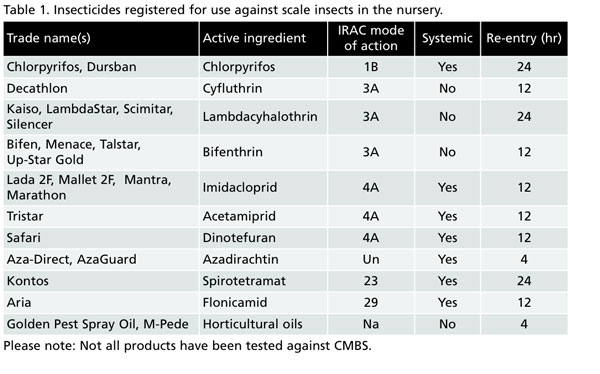10/1/2018
Crape Myrtle Bark Scale: A New Threat in the Nursery
Steven Arthurs, Kyle Gilder & Kevin M. Heinz

Crape myrtles (Lagerstroemia spp.) come in many shapes and sizes, but some now come with a new twist: a tiny insect, native to China, is now infesting these beautiful flowering trees in several southern states. Crape Myrtle Bark Scale (CMBS), first discovered in the Dallas, Texas, area in 2004, is threatening to turn what has traditionally been a perennial favorite with few pests into an unsightly, high-maintenance landscape tree.
Pictured: CMBS life stages encrusting a small crape myrtle branch.
Most reports of CMBS come from the landscape, however, nursery stock can similarly be affected. As of 2018, the pest has apparently spread to New Mexico, Oklahoma, Arkansas, Louisiana, Tennessee, Mississippi, Alabama, Georgia and North Carolina. (The Center for Invasive Species and Ecosystem Health maintains a website that includes a distribution map and a place where new CMBS sightings can be reported at: www.eddmaps.org/cmbs.)
What to look for
CMBS is easy to identify since it’s the only bark scale known to attack crape myrtles in the U.S. Adult females are about 1/10 in. and covered with an off-white, felt-like wax, while immature stages (nymphs) are pinkish-gray and lack the dense wax covering. These insects form dense encrustations on trees, including small twigs, branches and trunks. The female lays up to 300 pink eggs under her body and then dies.
The CMBS secretes sugary “honeydew” liquid, which can attract ants and leads to black sooty mold growth, especially on the bark and main trunk. When crushed, CMBS exudes a pink liquid, which is a sign that the scales are alive. Sooty mold alone isn’t a definite diagnosis; crape myrtle aphids similarly excrete honeydew (although more often on the foliage). However, if you observe whitish felt-covered scales that bleed pink, you can be fairly sure it’s CMBS!
While heavy infestations are easy to detect, newly infested plants are easily overlooked. We’ve noticed that infestations often start near pruning wounds or at branch crotches in older wood, which are good places to scout. If you’re unsure, contact your local extension entomologist for assistance.
How CMBS spreads
Since only males have wings, CMBS doesn’t spread by flying. The young crawlers that emerge from the pink eggs have well-developed legs and can reach adjacent trees with touching branches or can be spread locally by winds, or by hitchhiking on birds or even pruning equipment.
Older life stages are sessile and remain attached to the trees, often even after death. As a result, it’s not uncommon to find localized infestations within a tree or within neighborhoods or parkways with crape myrtle plants.
The industry can help manage the spread of this insect—long-range dispersal occurs inadvertently through transporting infested plants. We’ve observed CMBS-infested trees in retail outlets, thus contributing to the spread of this exotic pest in the landscape.
Steps to manage CMBS
Exclusion. Inspect propagation stock carefully for symptoms of CMBS. In the nursery, monitor trees on upwind borders for new infestations. Isolate trees with suspected CMBS infestations and either treat with approved insecticides or rogue to prevent the infestations from spreading. In the latter case, plants should be burned or buried to prevent risks of reinfestation. If disposed off-site, trees should be tightly tarped to prevent the escape of CMBS en route to disposal facilities.
Chemical control. CMBS can be treated with either systemic or contact-based insecticides. Systemic neonicotinoid insecticides effectively control and prevent CMBS infestations when applied to the root zone as a soil injection or drench. In the landscape, imidacloprid drenches applied against CMBS in the spring lasted a year or more, although less is known about how long container treatments will last. Keep in mind that it can take several weeks for these products to accumulate throughout the tree in sufficient quantities to kill the scale. Systemic materials are best applied before crawler emergence, when leaves first start to bud.
 Contact insecticides, such as bifenthrin, applied as bark and foliar sprays has been shown to kill crawlers and nymphs. Products containing the insect growth regulators pyriproxyfen or buprofezin are also likely to be effective against younger CMBS stages, but check if products are registered for nursery use in your area.
Contact insecticides, such as bifenthrin, applied as bark and foliar sprays has been shown to kill crawlers and nymphs. Products containing the insect growth regulators pyriproxyfen or buprofezin are also likely to be effective against younger CMBS stages, but check if products are registered for nursery use in your area.
Keep in mind that contact insecticides should be timed to coincide with crawler emergence, preferably in the spring, with a second application normally required after one or two weeks to target crawlers that emerge later (in Texas, this is typically mid-April to the beginning of May).
Horticultural oils have so far not been shown to be very effective during the growing season, although dormant season oils at higher concentrations may be beneficial if applied liberally to the bark and cracks and crevices where the scales overwinter.
Since some insecticides can harm pollinators and beneficial insects, only treat infested trees and those in the immediate surrounding area. Treated plants should be monitored and confirmed to be CMBS-free for a year to be sure the infestation is eliminated. The bark covered in sooty mold will look “clean” again after the crape myrtle sheds its bark.
Future prospects
The aesthetic impact of CMBS and potential costs of routine insecticide applications may reduce the popularity of crape myrtles moving forward. Unfortunately, there are currently no known crape myrtle varieties resistant to CMBS. Currently, research is being conducted in several states to learn more about this unusual pest and evaluate more effective control strategies, including importing natural enemies from China. Natural enemies of CMBS are especially important in the landscape, where many trees remain untreated.
In the meantime, paying attention to your crape myrtles and being on the lookout for CMBS will help ensure customers purchase a clean plant and this pest isn’t shipped to new locations. GT
Steven Arthurs (Assistant Research Scientist), Kyle Gilder (Graduate Student) and Kevin M. Heinz (Professor) work in the Department of Entomology at Texas A&M University in College Station, Texas. They’re currently funded by a USDA-NIFA Specialty Crop Research Initiative Program to conduct research on the CMBS.